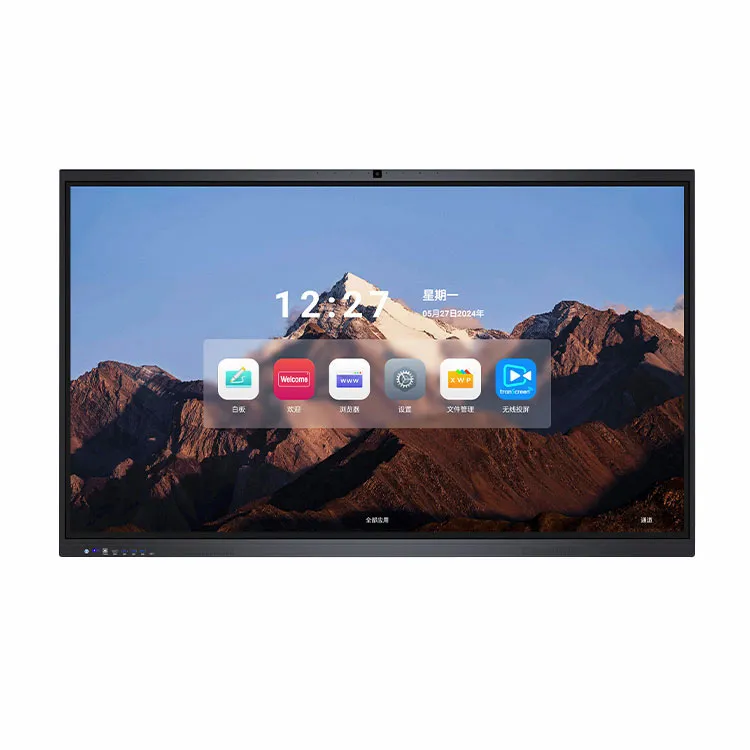What is the Difference Between an Interactive Display and a TV?
2024-11-15
In our increasingly tech-centric world, displays are everywhere, but not all screens serve the same purpose. Two popular choices—interactive displays and TVs—are often seen in vastly different settings, but many wonder what sets them apart. While both show vivid images and video, they cater to distinct needs and uses. In this blog, we’ll explore the key differences between interactive displays and TVs to help you understand when to choose one over the other.
1. Purpose and Target Audience
One of the biggest differences between an interactive display and a TV lies in their intended purpose:
- Interactive Display: These screens are designed for engagement and collaboration, most commonly in educational, business, and professional settings. Schools, offices, and conference rooms use interactive displays to facilitate teamwork, brainstorming, and presentations.
- TV: Primarily a home entertainment device, the TV is made for watching movies, shows, sports, and other multimedia content. Its purpose is largely passive, focusing on delivering an enjoyable viewing experience without requiring user interaction.

2. Touchscreen Capabilities
Perhaps the most distinguishing feature of an interactive display is its touchscreen functionality:
- Interactive Display: These displays are built with touchscreen technology, allowing users to interact directly with content on the screen. Whether writing with a stylus, tapping with fingers, or annotating documents, interactive displays make hands-on interaction possible. This feature is incredibly useful in education and business, where collaboration and real-time input are crucial.
- TV: Traditional TVs do not come with touchscreen features. You control a TV through a remote, which limits interaction to channel surfing, volume control, and menu navigation. Newer smart TVs may integrate voice commands, but they are still limited in direct-touch functionality.
3. Software and Built-In Tools
The software capabilities of interactive displays and TVs differ greatly, as they are built with different user experiences in mind:
- Interactive Display: Many interactive displays run on operating systems like Android or Windows, making it easy to download productivity apps and use pre-installed whiteboard, annotation, and presentation tools. Interactive displays are often bundled with collaboration software, which can include features for remote access, screen sharing, and split-screen views to accommodate multiple users.
- TV: Smart TVs also run on operating systems, but these systems are tailored for entertainment rather than productivity. Operating systems like WebOS, Tizen, and Android TV primarily support streaming apps (like Netflix, YouTube, and Hulu) rather than productivity apps, making TVs more suitable for consuming content than creating it.
4. Connectivity Options and Collaboration Features
Interactive displays are designed with connectivity in mind, offering a range of options for seamless collaboration:
- Interactive Display: These often include multiple USB ports, HDMI connections, wireless casting, and network connectivity options. Some models allow users to connect devices and share screens easily, making them perfect for team meetings and classrooms where quick connectivity is essential.
- TV: TVs have HDMI and USB ports and some screen-sharing abilities but are usually more limited in connectivity options compared to interactive displays. While TVs are fine for connecting gaming consoles, media players, and casting from a phone or tablet, they’re not designed with extensive collaboration tools.
5. Design and Durability
An interactive display is built differently from a standard TV, with features specifically geared toward a hands-on user experience:
- Interactive Display: These are built to withstand frequent touches, often with a rugged screen and anti-glare surface that make them easy to use in bright rooms. They are also designed with low latency so that any drawing or annotations appear instantly, without lag.
- TV: TVs, while available in durable models, aren’t designed for hands-on use and are more susceptible to scratches or smudges if touched frequently. They’re built to deliver sharp image quality and vibrant colors for optimal viewing, making them better suited for living rooms and other casual viewing environments.
6. Image and Display Quality
While both interactive displays and TVs aim for excellent picture quality, they prioritize different aspects:
- Interactive Display: These screens may not always prioritize 4K resolution or ultra-high refresh rates but focus instead on color accuracy, low latency for touch response, and visibility in various lighting conditions. Their design ensures that content is legible and clear from multiple angles, enhancing usability in group settings.
- TV: TVs generally prioritize high-definition resolution, vivid colors, deep contrasts, and high refresh rates to enhance the viewing experience. These specifications make them ideal for watching movies and sports, where image sharpness and motion clarity are essential.
7. Price Point
Due to their different features and functionalities, interactive displays and TVs can vary significantly in price:
- Interactive Display: With features like touch functionality, enhanced durability, and built-in collaboration software, interactive displays are typically more expensive than TVs of the same size. The price reflects their specialized role in educational and professional environments.
- TV: TVs, even large ones with smart capabilities, tend to be more affordable and are available at a wider range of price points. Since they’re designed for personal or home use, they offer a lower price point that makes them accessible for general entertainment needs.
Choosing the Right Device: When to Pick an Interactive Display or TV
To decide between an interactive display and a TV, consider your needs and setting. Here’s a quick guide:
- Go with an Interactive Display if: You need a screen for presentations, teaching, group activities, or brainstorming sessions. Interactive displays are designed for hands-on interaction and collaboration and will offer features tailored to these purposes.
- Choose a TV if: You’re looking for an entertainment-focused screen for watching movies, playing video games, or streaming shows. TVs are optimized for a comfortable viewing experience and won’t require the additional features of an interactive display.
---
Conclusion
While both interactive displays and TVs serve as visual tools, their distinct features make them suited for very different uses. Interactive displays shine in professional and educational settings, where touch functionality and collaboration tools add significant value. On the other hand, TVs excel in home entertainment, offering a high-quality viewing experience at an affordable price.
Ultimately, the choice between an interactive display and a TV comes down to how you plan to use it. By understanding these differences, you’ll be well-equipped to choose the device that best meets your needs.


